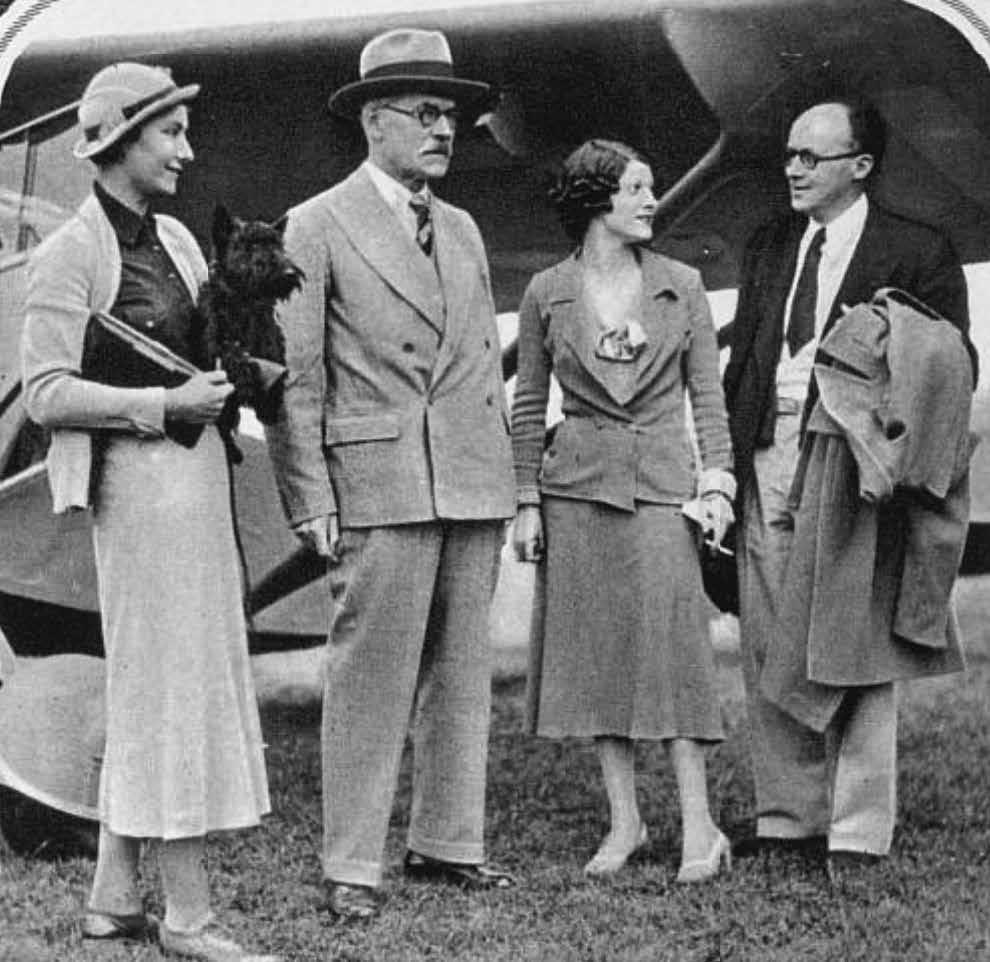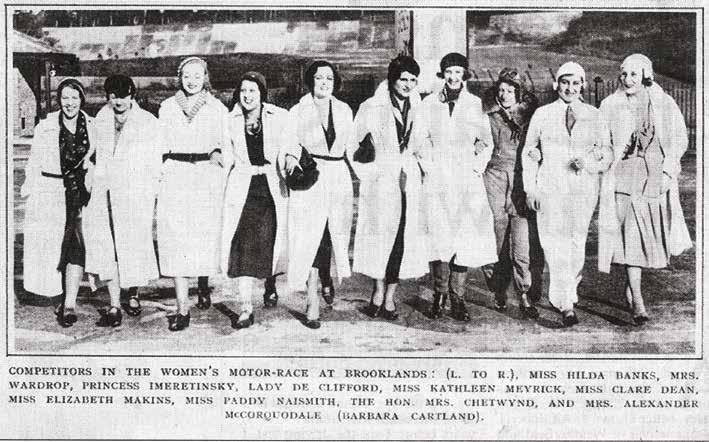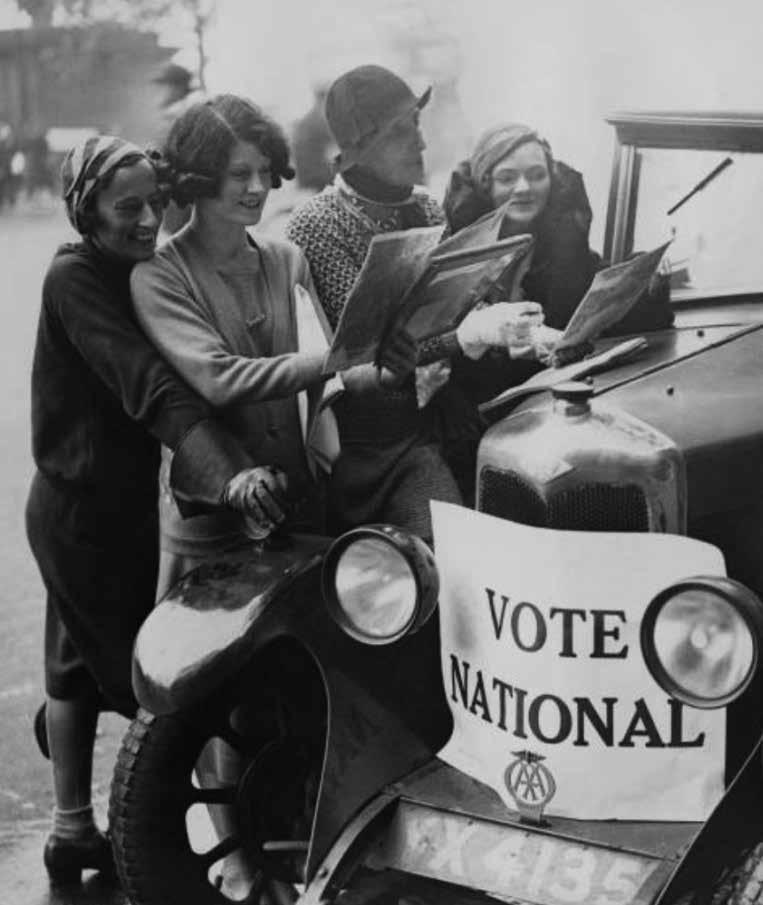
11 minute read
A full life
Paddy Naismith was one of the lesser known ‘Speed Queens’ of Brooklands. We chart an amazingly full life during which she was an actress, race and rally driver, pilot and air hostess.
Words: Roger Radnedge Photos: Brooklands Museum Collection/NPG
Advertisement
Eirane Redmond ‘Paddy’ Naismith was born in 1908 in London, the daughter of James Naismith who was originally from Ireland but had moved to London some time between 1902 and 1904 and was a travelling car tyre salesman. Paddy’s mother was Mary Francis Redmond Naismith, who was a renowned clairvoyant, though she called herself a psychological expert. Paddy had three sisters Sheila, Grace and Juliet and a brother Desmond.
In her teens, she began stage acting and this resulted in Paddy joining a touring company performing musical comedies. In April 1928, the Welsh Person Elder Company was busy adapting the popular works of WW Jacobs into a series of films.
They started with The Bravo and were looking for a new talent to perform the role of Lucy. After auditioning 50 young women, it was announced their ‘new discovery’ was the 19-year old Paddy Naismith, who was 24 by this time. Mr Jacobs said he was very impressed with her performance in a usually difficult role. The difficulty he pointed out was: ‘It is not easy to put my stories on the (silent) screen because they are nearly all dialogue.’
Paddy must have been paid well because in July 1928 she took part in the Junior Car Club’s Bournemouth Concours D’ Elegance with her own Ballot, but without notable success. Undeterred, in September she entered the Southampton International Motor Rally and this time
Paddy, second from right, is seen here with Sheila and Ramsay MacDonald to the left and Derwent Hall Caine. It demonstrates how well connected Paddy was in political circles.

she won a Special Award with the D Hall Caine Cup, igniting her interest in motor sport. In December, she starred opposite Edger Vosper in a film called The Lost Cord, described as a short drama. It must have been as they appear to have been the only performers.
As a rising starlet, Paddy made rapid progress up the social scene, aided by the friendship she struck up with Mr Derwent Hall Caine MP, who also acted. Hall Caine was also a friend of the Prime Minister, Ramsay MacDonald. Paddy was introduced to MacDonald and his daughter Ishbel and

The Standard Avon coupe that Paddy used to good effect in road rallies. This was just after she had won the Ladies Cup in the Ulster Motor Rally in 1931.

the women became friends. Hall Caine and Paddy enjoyed a very close relationship and she often acted as his secretary. It would seem that he proposed to her and he must have been pretty confident of her acceptance for he started to buy a house that was to become their marital home. The Scotsman newspaper picked up on this and on the 18 June, 1929 described her as his fiancée. Tatler repeated the suggestion, but in a later edition admitted its error and apologised for nothing came of it, probably because he was reputed have a string of mistresses and at least three illegitimate children. However, Paddy and Hall Caine remained close ‘friends’, and were often seen together as regular members of the Prime Minister’s golfing party.

Racing and politics
In July 1929, Paddy took part in the Brighton Motor Rally in her Ballot. She came first in the Concours d’ Elegance competition, second in Class 3 (£401- £800), and won in the ‘Any car over £400 which is owned and driven by a lady category’. Along with Hall Caine and the MacDonalds, she watched the Schneider Trophy Race on 7 September from the yacht Ianara owned by LieutenantCommander Montague Grahame-White, who was also a keen rally competitor.
Two years earlier, the Women’s Automobile Sports Association (WASA) was formed and Paddy became a member. However, it was not until the 4 October, 1929 that WASA held its first big event. This was a night running of the Middlesex Car Club’s Exeter Trial route. It was 300 miles long and included three observed sections comprising two hill climbs and a starting and stopping test. Thirty-eight cars took part, 17 of which were all-female crews. The drivers included Paddy in her Ballot which came complete with a cocktail bar and she was accompanied by one of her sisters.
On the 23 January, 1930 Paddy created a stir in Fleet Street by demonstrating a fire escape system. It consisted of a canvas seat attached to a 90ft length of steel cable which was slowly but constantly fed out of a mechanism, gently lowering the escapee to the ground. At the same time through her MacDonald connection, she started work as a part time chauffeuse for government ministers. In May, she drove the Vice-Chamberlain and the Comptroller of the Royal Household to Buckingham Palace, and in return the Chamberlain presented her with a silver horseshoe for good luck as she would be taking part in WASA’s London to Land’s End Trial over that weekend. The London participants departed from Slough and Paddy told the press: ‘This going to be a great event. We are going to show the men what we can do.’
Later that year, she competed in the Brighton and Hove Motor Club’s John O’Groats to Brighton Rally on 28 June to 1 July. Paddy had changed her motoring allegiance from Ballot to Standard and used a Sportsman Saloon. The next day she entered the car in the Concours d’Elegance and gained a prize in Class 6 for cars under £500. In the same year she performed in the film A Tale of Two Cities playing a character called Lucy Manette. Then, on the
At Brooklands in 1937, Paddy in the centre takes a stroll with some of her fellow female competitors.

27 September, she and one of her sisters entered the London to Lands End Rally driving Paddy’s Standard Tourist Coupe.
Becoming a stunt woman
As 1931 started, Paddy appeared in a film called The London Melody and, attracted by her fame and abilities as a demonstrator, the makers of Nuswift fire extinguishers hired her during January 1931. She put on a series of very dramatic demonstrations using both her own car and an Austin, which involved putting out engine fires in both cars. During the 10-week tour, she apparently did this about 25 times. In February, her film roles changed and she became a stunt woman in the Warner Brothers’ film Long Live the King. Her particular stunt involved falling out of a moving car, running after it, then cart wheeling over the back of the car into the driver’s seat.
In April 1931, she and Derwent Hall Caine again joined the MacDonald’s on their golfing holiday at Spey Bay in Scotland. The following month, a minor disaster occurred when she lost her pet dog Binkie, a wirehaired terrier. She told the Lincolnshire Echo she was about to set out on a 2000-mile tour of England to look for it. It was said Binkie was something of a hero because he had saved a man from drowning by attracting the attention of people in a nearby field. This was after he had made an attempt to rescue the man himself.
In June, Paddy entered another WASA event. This midnight run started at Virginia Water in Surrey and ended in Westward Ho, Devon. It was about now she made one of her more notorious comments, namely ‘Men don’t know how to keep their motor cars clean and lovely.’ The next rally in mid-August was an altogether larger affair as it was the first Ulster Rally, which was a very demanding event that Paddy used a Standard Avon for. The entrants had to drive day and night over 500 miles and arrive in Bangor, Northern Ireland at 3.30pm. Paddy drove all the way herself, though she was accompanied by her brother. She declared: ‘It’s going to be great fun. I shall go from Dover and the prospect of driving rigorously to a schedule alone all night does not dismay me in the least. A more difficult rally has never been held before as we must keep to a 24mph time schedule for the whole way without being more than 30 seconds out at any check point if we are we not to lose marks and any chance of an award. Yet the women drivers welcome the stringency. It will give us a chance to compete side by side with men and setting by the heels the bogey of women’s faulty driving.’
Paddy ended up winning the Ladies’ Cup and the next day took part in the Concours d’Elegance, where she came first in the Class 2 for cars under 10hp and second overall. Her car was painted yellow with the chassis, wings and upholstery in green. She wore a matching frock of yellow broderie, a yellow raincoat with applications of green. Her long boots were of silver to match the tyres of her car.
The next rally was on 18 September, 1931. The 300-mile Peaks and Lakes Trial to the Lake District looked like it would be far less challenging, but as it turned out it was just as demanding but in a different way. It was the weather that provided the challenge and 30 women entered, but in the end the weather whittled it down to only 11 starters. The demanding Park Rash hill climb was only completed by Paddy and
three others. Her brother Desmond said that during the climb they were ‘bumped and bored, swung from side to side and did everything but aerobatics.’ Amazingly, throughout the trial she had lost no marks and was one of only two drivers to gain a Gold Medal. Then, on the 17 October, Brooklands ran an event to coincide with that year’s Motor Show where Paddy participated alongside many other notable lady drivers of the day.
October saw the run up to the General Election and Paddy reprised her role as transport organiser for Ramsay MacDonald’s National Party. It was claimed she assembled and controlled 42 aeroplanes, 612 cars and 12 speed boats, all at the disposal of the party’s candidates. She often used her contacts in WASA to do this. Paddy was by then deep into politics and had become the president of the South Tottenham women’s branch of the Labour Party, making her one of the youngest members to hold such office.
Probably because she was a well-known driver, she became involved in a stunt organised by novelist Barbara Cartland. It was said that during one of Cartland’s house parties, a male guest made a remark along the lines that for all their recent publicity women drivers lacked the skill of their male counterparts. Cartland decided to set up a demonstration that proved otherwise. She called it a ‘practical solution’ to the question ‘do women drive motor-cars with as much skill as men?’
Cartland persuaded a group of 10 society ladies to take part in the event to show off their driving skills. It would take place at Brooklands during the closed season and be filmed by Movietone News, and the film can be watched on YouTube.
During the event, the women proved themselves fearless. Princess Imeretinsky misjudged the corner near the Fork and ended up doing a 180-degree skid. However, both she and her passenger Lady de Clifford were thrilled by the incident and on arrival at the finishing post the princess shouted: ‘Did you see that delicious skid we had? We turned round twice.’ Her passenger is reported to have added the spin was ‘too, too marvellous my dear!’ Paddy crossed the line first. However, this was a handicap race, which seemed to be worked out on social standing rather than motoring ability. So, the princess was declared the winner, second came the Hon. Mrs Joan Chetwynd and third was Paddy. All seemed well until the December edition of The Motor was printed and exposed the whole thing as a staged event. This caused great embarrassment among the serious
Rallying
On 1-5 March, 1932 she and two of her sisters took part in the first RAC Rally to Torquay, driving a Standard Avon saloon. During the event, they suffered a bad accident when speeding along the Camberley Road they hit an icy patch that caused their car to ‘charge the hedge and turn over, trapping her and her two sisters inside. Earl Howe came to their rescue, they were bruised and shaken but otherwise fine.’ However, both front
wings and an axle were very bent. Even so, in this much damaged car now minus a wing and with two wobbly wheels, they managed to stagger into Torquay.
Despite the accident, they still entered the Concours d’Elegance and overnight they obtained two new wings and their mechanics put in a lot of work. The next day, they won the Coachwork Competition for Occasional four-seaters and two-door sports saloons in the 1100cc category. Although the car was small, it was fitted with a wash basin and small dining table.
In July 1932, Paddy became one of the founding members of The Stage and Film Aero Club and she served on its committee. Its home airfield would be
Heston and the club’s first event was a
Garden Party on Sunday 24 July. Paddy made her first solo flight shortly after on the 7 August, 1932.
Back at Brooklands on the 10 September, Paddy won a three-lap Ladies Handicap driving a supercharged Salmson at 86.30mph. Elsie Wisdom had lapped at 113.97mph in a LeylandThomas, but her race handicap was so great it put her out of contention.
Read Part 2 of Paddy Naismith’s story in the next issue of the Bulletin.





